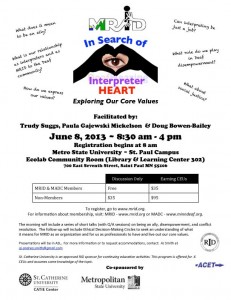As I sit here working well past midnight, I can’t stop thinking about the most random encounter at Target last Saturday that lasted all of three or four minutes.
My family and I had just arrived at the store, and my younger two were throwing hissy fits over having to sit in the cart (control, folks; carts are how we control our younger kids in stores). My oldest two were pushing each other and giggling. As I attended to the youngest — deeeeep into her terrible twos, which means she screams bloody murder if we try to make her do anything — I saw a father with two kids walking by. The oldest, an adorable boy with the cutest black-rimmed glasses, shaggy short hair, and a green shirt (soccer game, maybe?), kept staring at us. I ignored him at first thinking he was just some hearing kid fascinated by our ASL or our unruly children. But then I looked up, and suddenly noticed his hearing aids with the coolest green ear molds. He had stopped in his tracks, and was watching us intently.
I was trying to calm my daughter down while my husband was herding the other three. As I looked down at my daughter, I could see, and feel, the boy staring at us from maybe five or ten feet away. He seemed to be eight or nine. His father and sibling had already gone into the dollar bins area, and he was standing there, staring at us with so much interest. As I got my daughter happily comfortable in her seat, I mentally debated about how to react to the boy’s gaze. Should I ignore him? Does he know sign language? What if I try to talk to him and his dad gets upset? What if he doesn’t sign and doesn’t understand what I say? What do I do? Are my kids ever going to calm down?
I glanced back at him and gave him a big smile as I snapped my daughter’s cart belt into place. “Hi!!” I signed, looking at him directly.
The biggest smile came over his face as he excitedly signed back, “HI!” Just then, his father came back, looking a bit unhappy at his talking to us. The boy looked reluctant about having to join his family, glancing back at us twice as he walked off. I hoped to see him again in the store so I could talk a bit more with him, but I never saw him again.
I’ve been thinking about him a lot since then. The look on his face was so filled with hunger and hope. It’s a look I’ve seen a million times before, usually on the faces of deaf children (or even adults) meeting other deaf people for the first time. It’s the look of realization that they’re not the only deaf person in the world, that signing is perfectly acceptable and natural, that we’re all incredibly ordinary people just like them. I am so grateful that I have never felt like the only deaf person in the world, because I’ve always had deaf role models around me from day one of my life. I’ve never gone a single day in my life wondering what other deaf people were like or if they even existed.
I’ve also been thinking a lot about my children and their unfiltered, unlimited access to communications 24 hours a day at home and in school. They will not realize for years to come just how fortunate they are, just like my husband and I didn’t realize how fortunate we were to have deaf families and 24-hour access to sign language. I’m extremely grateful that I can chat with and listen to my kids, especially their references to poop and boogers. I’m also fortunate every single person in my household can argue, joke, and love each other without a single communication barrier, even if it means we (namely me) have to be careful what we say at the dinner table because every word we say gets repeated the next day in school, thanks to my children’s eagle eyes.
I hope that the boy in Target is in an environment where he can sign freely and can be as deaf as he wants to be, to whatever degree. Maybe all my assumptions are wrong, and he’s perfectly happy. I just wish I had paid more attention to him once I realized he was deaf. And I so wish I had said hi sooner.
